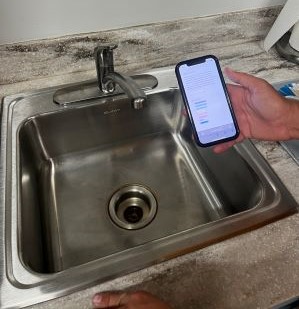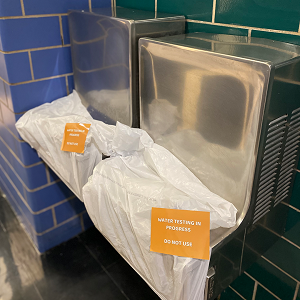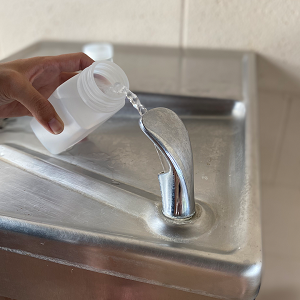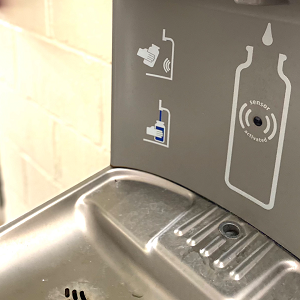Collect Samples
Test for lead in drinking water by properly collecting samples.
With proper training and instructions, anyone can collect samples from drinking water outlets (e.g., drinking fountains, classroom sinks, kitchen faucets) to test for lead. All samples should be analyzed using a certified lab.
 1. Complete an outlet inventory
1. Complete an outlet inventory
Our easy-to-use online tool will help you identify, properly number and label drinking water outlets for testing. If you have a large number of samples to collect, please contact us about other options for completing the inventory.
After completing the inventory:
- If you are eligible for free testing (all public schools and licensed child care facilities), and choose to participate, the lab will automatically be notified to ship the correct number of sample containers to you.
- If you are NOT eligible, or choose to use your own lab, you will receive a list of your sample locations and sample IDs, the number of sample bottles you’ll need, and a list of NH-accredited labs that can complete the testing for you (at your own expense).

Quick Links
 2. Prepare for Sampling
2. Prepare for Sampling
Plan ahead. Any drinking water location that can be used for drinking or food prep should be sampled. Showers and sinks that are only used for handwashing or dishwashing do not need to be sampled. If you are unsure whether an outlet is used for consumption or cooking, err on the side of caution, and plan to collect a sample.
Request sample bottles from a certified lab. The number of sample bottles should match the number of locations (drinking fountains, classroom sinks, kitchen faucets) that you plan to sample. Sample bottles should be 250 mL. Public schools and child care programs are eligible for free water testing from approved laboratories. View the Find a Lab webpage.
 3. Collect Samples
3. Collect Samples
Samples that are collected should be “first draw.” First draw samples are collected from cold water outlets, immediately after turning on the faucet or drinking fountain. Water should not have been used for 8 to 18 hours prior.
Typically, first draw samples are collected first thing in the morning, before anyone has used the water.
As you collect samples, properly label the bottles and fill out the chain of custody. Return collected samples to the lab for analysis.
Sample Collection Instructions
Project Chain of Custody – Excel version
WATCH OUR VIDEO ON COLLECTING SAMPLES
WATCH OUR VIDEO ON LABELING SAMPLE BOTTLES AND COMPLETING A CHAIN-OF-CUSTODY FORM
 4. Take Action
4. Take Action
Locations with sample results at or above 5 parts per billion (ppb) must be remediated, and parents and guardians must be notified within 5 days of any exceedances. View the Communicate and Take Action webpage for guidance on fixing locations with elevated lead and details of notification requirements. We encourage you to share the test results with parents and guardians, regardless of the levels detected. An easy way to share the results is to provide a link to the View Results section of our website.




